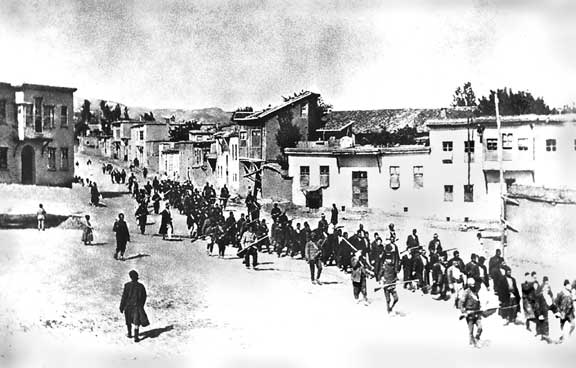
To the memory of Stepan Shaumyan, Armenian Bolshevik leader of the Baku Commune in 1918, and of Hrant Dink, Armenian socialist intellectual from Istanbul who, until his assassination in 2007, exerted a Herculean effort to bring the genocide into the centre of attention in Turkey.
On April 24, 1915, hundreds of Armenian intellectuals, politicians and community leaders were rounded in Istanbul (or Constantinople as it was then called in the West) by the Ottoman state, to be subsequently sent to exile from which most never returned. This was the signal that set off a chain of events that ended in a tragedy the like of which has rarely been witnessed in the annals of modern history. The Armenians, who had been living in the eastern part of the Anatolian plateau from time immemorial, were forcibly deported from their homes in almost every city in what is now Turkey, ostensibly to their destination Dar ez Zor in the Syrian desert. Up to a million and a half died in the process. Women were abducted, raped and killed. Young children were sent to orphanages and forcibly Islamized. All the property belonging to Armenians, houses and gardens, farms and orchards, cattle and sheep, workshops and tools, trade houses and factories were seized by the state or simply grasped by the Turkish ruling strata. Churches were made into warehouses or left to rust and community hospitals and schools were taken away.
On the eve of World War I, different estimates and censuses put the Armenian population of Anatolia between 1.2 million and close to 2 million. At the end of the war, the only sizeable Armenian population was left in Istanbul and the overall figure had fallen below a mere 100 thousand. What was to become present-day Turkey was thus “cleansed” of its Armenian population. The Turks had entered Anatolia as a result of the victory obtained by the Seldjukides over the Byzantines at the Battle of Manzikert in 1071. They cohabited with the autochthonous Armenians for close to a millennium. The Ottoman Empire regarded the Armenians as the “loyal nation,” and yet it was this very same state that betrayed them, massacred them and extirpated them from their homes and their motherland.
Implications for the Future of the Middle East
There is not a shred of doubt that this was genocide of the worst kind. Of course, the concept may sound like an anachronism in this context since it was first coined as a legal concept in the aftermath of World War II. However, we do not approach the question of the Armenian genocide from a legalistic viewpoint. Our concern is to re-establish friendship and trust between the workers and labourers of Turkey and Armenia. For us this is first and foremost a political question that has to do with the prospect of revolution in the region. All social upheavals in the Eurasian land mass from 1905 and 1917 to the period 1989-1991 passing through World War I witnessed massacres involving the Armenians, the Turks and the Azeris, the latter being the ethnic brethren of Anatolian Turks inhabiting the Caucasus. On the other hand, the Armenians and the Kurds each claim roughly the same geographic territory as their historic motherland. So the fate of the revolution in the Caucasus, Anatolia and Mesopotamia hinges upon the relationships established between these four peoples. Proletarian revolution cannot succeed here unless it sets in motion a process that culminates in the Socialist Federation of the Caucasus and in parallel the Socialist Federation of the Middle East, where Turk and Armenian and Kurd will have to cohabit. Hence the debate on the Armenian genocide is by no means a futile exercise on a long bygone historic event, but really concerns the future of the revolution in this whole region.
The Turkish state and those historians and intellectuals who act as its mouthpiece have consistently denied the genocide. Their arguments range from the minimization of casualties (the lowest figure cited being 320 thousand as against the 1.5 million put forward by many Armenian and other historians) to the claim that the massacres were reciprocal. They forget two simple facts. First, the Armenian population of eastern Anatolia was almost totally eradicated from the face of Anatolia. So to count the numbers of the dead is only a part of the genocide debate. Secondly, state power was in the hands of the Turkish dominant nation, which renders all talk about mutual carnage empty chatter.
Genocide as Class Struggle
The classical explanation offered for this barbaric cruelty by liberal historiography in Turkey and nationalist historiography of the Armenians both in contemporary Armenia and the Diaspora has been that it was the outcome of the “construction of Turkish identity” or of “Unionist mentality,” the latter implying the world outlook of the Committee of Union and Progress, the party then in power. These are, of course, philosophically idealistic approaches that beg the question of why the identity or the mentality in question became dominant specifically at that historical juncture. But there is worse. It is a very widespread view among Westerners, Armenians and Westernized Turks that somehow the Muslim or the Turk or both partake of some kind of evil, that it is from the nature of the religion or the ethnicity in question that this barbarism proceeds. This kind of racist characterization is hardly ever pronounced in writing or in public nowadays, but it is still voiced in private conversation.
Our view on the determinants of the Armenian genocide is fundamentally different from almost all commentators. We assert that what lay behind the Armenian genocide was class struggle of several orders. The vicious attacks against the Armenians had its earliest roots in the looting of the surplus product of the Armenian peasantry by the ruling stratum of Kurdish tribes, which shared the same geographical territory with the Armenians. The later but stronger and more radical drive came from the urge for primitive accumulation on the part of the nascent Turkish bourgeoisie at the turn of the century fighting against the economic dominance of the non-Muslim moneyed classes in Ottoman society. It was this class fraction that was represented by the Unionists in power and dispossessed the Armenian and, in a different manner, Greek population of Anatolia to amass capital in its own hands. Marx's remarks on primitive accumulation in Capitalsound prophetic in regard to the Armenian genocide: “If money, according to Augier, ‘comes into the world with a congenital blood-stain on one cheek,’ capital comes dripping from head to foot, from every pore, with blood and dirt.” In Turkey the blood and dirt of primitive accumulation took the form of genocide.
These domestic factors were reinforced by the support extended to the Turkish bourgeoisie by the German imperialist bourgeoisie, instrumentalizing the power of the Ottoman state in its intra-class struggle against the other imperialist bourgeoisies of Europe, that is, British, French and Russian.
The Importance of German Complicity
This last fact is of utmost importance. Germany was the ally and protector of the Ottoman state during World War I. The commanders of the Ottoman-Turkish army were German field marshals, generals and admirals. It is absolutely impossible for the genocide to have taken place without German consent, even positive encouragement. The German Kaiser and the Reich were already responsible for the genocide of the Herrero people in what was then called German Southwest Africa, what is present-day Namibia. Hence, there is no reason to rule out even a scenario in which Germany may have instigated the ruling Union and Progress Committee and its strong man Enver Pasha to implement this “final solution” to the Armenian question. Enver Pasha was a personal protégé of Kaiser Wilhelm II. The latter is notorious for his secretive and personalized management of foreign and military affairs. The Kaiser's government expected the Ottomans to threaten both Russia and Britain in their Asian backyards by propagating a simultaneously pan-Turkist and pan-Islamist political onslaught. The Armenians stood in between the Ottomans and the Muslim and Turkic peoples of Asia. Hence, in an objective sense, the Armenian genocide served the wartime aims of German imperialism.
Of course, all this does not necessarily mean the German government was involved as an accomplice in the genocide. However, it is only through a study of the archives, including top secret documents, that the truth of this matter can be discovered.
Where does the significance of all this lie? Let us start with a general proposition. Recognition of the genocide is the primary act in the direction of redressing the suffering of the Armenian people and of rekindling a modicum of fraternity and trust between the peoples of the region. The problem is that, left on their own, Turkey and the Armenians, both Armenia proper and the Diaspora, have locked horns for a very long time. The Turkish state and those historians and intellectuals who act as its mouthpiece have consistently denied the genocide. The absurd concept of the “Turkish thesis,” denoting full denial of the genocide, is testimony to the stubborn position of the Turkish state. The titanic effort of Hrant Dink, an Istanbul Armenian formerly a revolutionary socialist, to create an awareness of the question throughout Turkish society in the 1990s and early 2000s created an immense breach in the wall of silence that had earlier been imposed. Hrant Dink was assassinated in 2007 through a conspiracy prepared by the so-called “deep state” of Turkey, but his legacy lives on. If we are today able in Turkey to discuss this question openly, most of the credit goes to the Herculean work carried out by Hrant Dink and his still extant bilingual weekly Agos. However, the overall situation cannot be said to have changed irreversibly. The genocide is still mentioned in the media perforce as “the so-called genocide.”
The question of the recognition of the genocide cannot be resolved by the ill-conceived pressures of the state organs of some imperialist countries and is positively harmed by such irresponsible theatrics such as that of the Pope in early April, conspicuous for its lack of modesty coming from the head of an institution wholly immersed in the Holocaust. However, for the reasons explained above Germany is the exception.
It is a noteworthy fact that although many European governments and parliaments (including France, Belgium, Italy, Greece, Switzerland, the Netherlands, Sweden etc. and the European Parliament recently for a second time) have recognized the 1915 events as genocide and called on Turkey to do likewise, Germany has remained very much in the shadows on this question. This fact glares with significance.
We believe that it is the duty of the German socialist and working-class movements and German democrats to press for the complete opening of German archives relevant to that historical period. We summon them to press the German government to recognize and condemn the Armenian genocide.
If Germany does recognize the Armenian genocide, with documents in hand, the Turkey-Armenia polarization will be cast in a new light and the obscurantism of the “Turkish thesis” will receive a fatal blow. This is the only way to fraternity and trust between the peoples of the region.
Needless to say, the real effort to make the Turkish government recognize the genocide falls on the shoulders of the Turkish and Kurdish left. We appeal to the German and international movements for efforts without forgetting for one single moment that the blood spilled by the Turkish bourgeoisie and the Kurdish tribal ruling class can only be cleansed by the Turkish and Kurdish proletariat and the peasantry.
"This was initially published on the Canadian web site Socialist Project."
